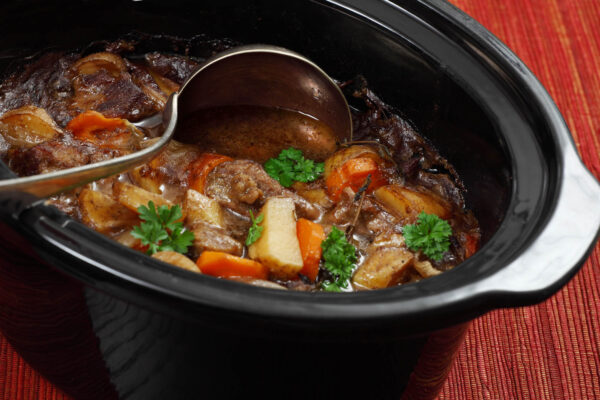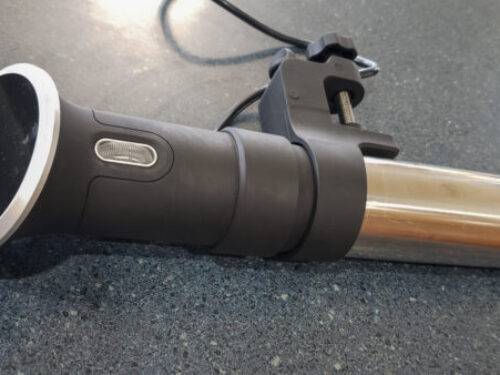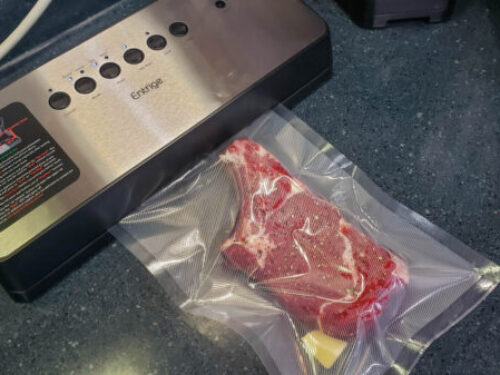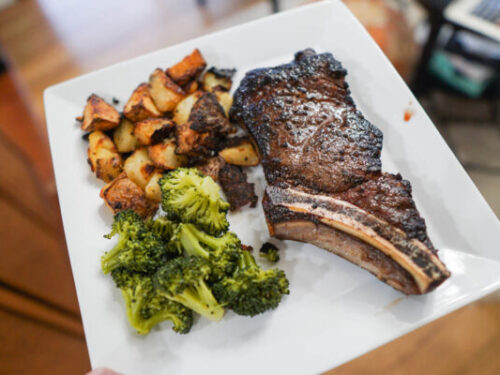As soon as you learn a bit about sous vide, you come to find out that the tool is a slow cooker. When we think of this kind of set-it-and-forget-it cooking, most people's minds go to the tried-and-true crock pot for slow cooking at home.
While it is true that both sous vide and crock pot use the power of time (specifically a large amount of time) to make delicious food, they each have their own sweet spots that make them useful in our homes.
In this one, we wanted to share some of the strengths and weaknesses of each as, if you're anything like us, you may find yourself wanting both! So let's jump into it with a crock pot vs sous vide breakdown!
Crock-Pot Cooking
While we suspect you are likely quite familiar with how a crockpot operates, we should start with breaking down how this one works.
In most configurations a crock pot is simply a large ceramic vessel with lid that rests on top of a heating element that often has temperature settings of low, medium, and high which can translate to temperatures between about 175 °F and 300 °F depending on the model. This is coupled with a timer that can automatically turn the crockpot to a warm setting to enjoy at your ideal dining hour.
While a crock pot can be used for many meals, home chefs are often drawn to this one when making soups, chilis, and other sauce-heavy dishes in order to have a layer of food (often liquid coated) touching as much surface area as possible to draw in heat and cook (not to mention, thicken and meld flavors at boiling). Some recipe sites suggest that dry ingredients like meat can also be cooked in a crock pot but is often recommended to have a braising liquid in it to help manage the energy transfer efficiently and safely.
We, personally, do not ever cook dry food in our crock pot out of an abundance of caution.
One of the downfalls of crock pot cooking beyond this is that you often do not have full control over the temperature settings. But, as most cooks in this are liquid heavy that require boiling conditions for an extended period of time, this lack of control is often not really an issue either- heating to boiling is what you want and what you get.
Sous Vide Slow Cooker
Sous vide, on the other hand, is a water bath immersion circulator. Rather than heating food in a pot directly, sous vide is designed to heat a water bath and hold it at a set temperature. Food is inserted either via freezer bags or vacuum bags and the water circulates at that set temperature around the outside of the bag, transferring heat into the food, and thus cooking it.
There are two main benefits to sous vide over a crock pot. The first is that you have greater control over the cooking temperature (sous vide typically runs between room temperature and just under boiling with about +/- 1 degree accuracy) and the second is that you are much more likely to use it to cook conventionally dry foods in it like steak, pork chops, vegetables, and more. Rather than immersing these in a sauce or braising liquid to transfer external heat into the food (as you would in a crock pot), the water bath does this all while being separated from the food via the plastic bag.
The downside to sous vide is that it generally does not include a timer or has the ability to switch to a “warm” setting- this has to be done manually on the device itself or via WiFi enabled models. But as long as you are cooking outside of the danger zone of food (> 140 °F) or within pasteurization tables, you could leave most items in the sous vide for hours (or days!) with the texture being the only discernable difference (traditionally tough roasts break down beautifully with a 48 hour cook).
One of the downfalls of sous vide cooking is that generally you will not cook large volumes of sauce-heavy dishes as they can be harder to deal with (although it is certainly not impossible- freezer bags and ball jars offer some great solutions for cooking liquids in a sous vide). Likewise, while some sous vide units may run to just under boiling, most users tend to cook with freezer bags or vacuum bags which have an upward limit of about 190 °F. If you need to boil your meal, like a soup, it is best to go with a crock pot.
Which is Better? Crock Pot vs Sous Vide
While it should be readily obvious that a site like ours is inherently biased towards sous vide, we have to admit that both the crockpot and sous vide slow cookers have their respective merits- and we own both.
If I want to make a big pot of soup, have it simmer for a few hours and then transition to being held at a warm temperature, I'm going to use a crockpot. While we have used our sous vide for cooking liquid heavy dishes in freezer bags (Sous Vide at Home has a stellar chicken tinga recipe that we adore), we tend to cook more dry foods in this device- think vegetables, steak, chicken thighs, you name it.
The main difference between the two devices is temperature control. A simmering soup just needs to boil for a while to help bring the ingredients together. A steak is perfectly cooked at 130 °F and, in our opinion, 130 °F alone (there is no alternative to medium rare). Therein lies the difference. You most certainly will not make a perfectly set creme brulee or a pot de creme in a crockpot, but with the temperature control of a sous vide you can make some that set perfectly every time. Repeat this with many of the foods we mentioned above and it holds true time and time again.
So while both of these technologies are slow cookers by design, they each have their own function and as such they are both used regularly in our house.
However, as our crockpot has been relegated to liquid-heavy dishes and sous vide for primarily dry dishes, you can imagine that our sous vide sees far more cooking projects overall- we simply do not eat that much soup, chili, or otherwise braised meals overall. As with everything, your own preferred cooking style really comes into play here, and when it comes down to it there is nothing wrong in having both!
Disclaimers: Our site uses demographic data, email opt-ins, display advertising, and affiliate links. Please check out our Terms and Conditions for more information.
Read More About Sous Vide
Want to learn more about sous vide cooking? Check out some of our top posts:






